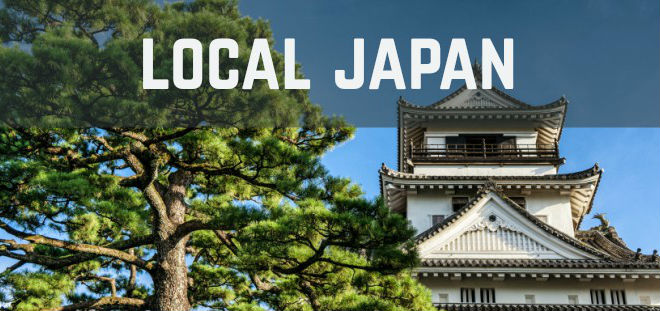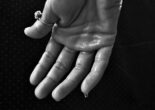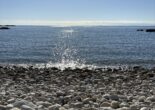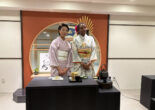
Local Japan: Kochi – the city of natural beauty and crazy party people
Kochi Prefecture stretches east to west, across an arc of land that forms the southern coastline of Shikoku Island. In roughly the mid-point of this arc sits the prefectural capital, Kochi City. Lush green forests cover the mountains, rivers with the purest water in the country, flow down to the Pacific and a warm ocean current brings the bounty of the sea up along the coast. Shikoku is the least known of the four main islands of Japan, and Kochi is the most mysterious of the four lands that make up Shikoku.
The city has a population of around 330,000 meaning it is outside the top 50 largest cities of Japan and putting it on a par with Santa Ana, in California, Cardiff in the UK and it’s slightly smaller than Nice, in France.
Thanks to its size it easy to get around. The city is connected by a good tram system, along with rail lines that run out east and west. But for the city center, a bicycle is all you need to get around. Again thanks to its size, you can quickly get out into the countryside; the mountains to the north, beaches to the east and rivers and beaches that lay to the west.

Kochi people are party people!
If you ask a Japanese person what they know about Kochi chances are one thing they will tell you about, is Yosakoi.
Yosakoi is one Japan’s wildest celebration. This festival takes place in August, the hottest month. It continues over four days with teams dancing for hours whatever the conditions: in the sweltering heat, in the rain, through the day and into the night. Thousands of young people come from all over the country and recently from abroad, to join in. For many just to take part, just to be able to say: “I danced the in Yosakoi in Kochi” is enough, but for the local teams competition is fierce. Training is tough and starts months before the event. Finding somewhere to stay at this time is challenging, be sure to book well ahead. I’ve watched the teams dance and the effort they put in is amazing. For a photographer, it’s a tough time too, the streets are packed with dancers and onlookers jostling for space. It is the only festival I’ve experienced in Japan that feels like a carnival because unlike other more traditional festivals, more young people are involved and there’s much more flexibility and expression in the dances, in the costumes and with the trucks that carry the deafening sound-systems.
 Kochi is a land of mystery and spirituality too.
Kochi is a land of mystery and spirituality too.
The 88 temple pilgrimage route, established by the monk Kukai, born in 774, runs through Kochi as it makes its way around Shikoku. The constant stream of pilgrims passing by brings an air of spirituality to the everyday. Pilgrims dressed in white can be seen traversing the 1200 km route all year round but because of the heat of summer and typhoons, spring and winter are more popular. Walking the whole route takes more than a month and many choose to do it in stages. Myself, I have travelled some of the route by bicycle to cut down the time and still push myself physically. I’ve still yet to follow the whole route. Kukai travelled to China in 804, studying in Xian, on the edge of the Tibetan cultural zone and as such, one can feel the influence of Tibetan Buddhism in the mandala that decorate the temples along the route.
A land of great natural beauty.
My favorite way to chill out in summer is swimming and free diving in the ocean amid the coral reefs of Tosashimizu in the west of Kochi. Whenever time and weather permit I head to the sea. I’ve tried surfing a few times and have my own longboard but can’t call myself a surfer. I do fully intend to learn and the place to do so is nearby – there are two good surf schools at Irino Beach and Oki Beach, the breaks at these two spots are good enough to challenge the experienced surfer but kind enough to let the beginner off the hook!
 Then there are the rivers, Kochi’s two most famous rivers, the “Niyodo” and the “Shimanto” are consistently found (by government research) to contain the purest waters in Japan. The fact that there is very little in the way of heavy industry means that the land, the rivers and the oceans are almost immaculate here in Kochi. Rafting and canoeing on some world class white-water is available in Otoyocho, Kochi (the 2017 Japan Rafting Championships were held here in August) and there’s more relaxed canoeing on the lower reaches of the Shimanto River, great for families with kids.
Then there are the rivers, Kochi’s two most famous rivers, the “Niyodo” and the “Shimanto” are consistently found (by government research) to contain the purest waters in Japan. The fact that there is very little in the way of heavy industry means that the land, the rivers and the oceans are almost immaculate here in Kochi. Rafting and canoeing on some world class white-water is available in Otoyocho, Kochi (the 2017 Japan Rafting Championships were held here in August) and there’s more relaxed canoeing on the lower reaches of the Shimanto River, great for families with kids.
If you are in need of some quiet time for contemplation, I recommend a walk into the forests. 86 percent of Kochi Prefecture is forested. This place is so green! Some of the forests are original forests and are left practically untouched. Others have been sustainably producing timber for over 400 years. A few years back I worked as a lumberjack and though it was hard work it was wonderful to be out in the forests, working in a small team.
In the forests you will find ancient shrines hidden away. These sacred places have an atmosphere that calms the mind and gives a sense of the true extent of time and quiet power of nature. These shrines are places of contemplation; they are not swarmed by hordes of tourists like the famous shrines of the main island of Japan: Honshu. In the forests you will find many wild creatures but thankfully, no bears!
I was in the woods of Yokogura (an hour’s drive from Kochi) just recently. There was no wind that day and everything was so still…not a sound of cars, trains, planes and the ground was bursting with life (October is still very warm here). I wandered into the grounds of a shrine where six hundred year old trees towered into the skies…magical!
All this nature, the mountains, rivers and ocean are accessible within a couple of hours from Kochi City.

Kochi people love to eat …& drink!
I love the food in Kochi! Its uses of fresh ingredients sourced mostly locally from amid its unpolluted surroundings. The food that they produce is so rich in nutrients and so low in toxins; just living here is a no effort detox! The extensive use of ginger and garlic means dishes are flavorsome. Tataki – is the number one favorite. Filleted skipjack tuna are lightly seared in flames (usually straw is used). You’ll often see a bright flare of light coming from restaurant kitchens as the fish are thrust into the flames. The fish is then sliced and flavored with a combination of salt, garlic, ginger, myoga (something like ginger… but not!) soy-sauce and yuzu, depending on that shop’s preference. The flavor of the small citrus fruit “yuzu” is very popular in Japan, and Kochi is a major producer. Recently it seems the yuzu has become popular in French culinary circles – so maybe it will be seen more on the world-wide epicurean stage from now on.
A few words about fishing for the skipjack tuna: it is fished in a very simple way that is both efficient and ecologically sound. Individual fishermen hold out long fishing poles from the deck of the boat and hook in one fish at a time. No nets, no long-line fishing are used by Kochi fishermen, so there’s no incidental impact on other species. There are fixed net fisheries conducted along the coast for other fish species however, but as the fishermen check the nets twice a day the impact on other, untargeted species in minimal.
Kochi city is a vibrant city, fast opening-up to the world and with a fascinating history. The castle located in the city center, is unusual in that it is original, dating from the mid 1700’s, not a concrete facsimile. The city center still retains its charm as it is not dominated by the usual department stores and discount electronics outlets one sees in so many cities. What it does have is a thriving downtown area with many small, local shops, cafes and bars. Since about two years ago a small art-house cinema has been open upstairs from the marvelous Café Mephistopheles in the city center. I come here to watch films, mostly documentaries, both homegrown and imported.
There is a high density of museums and art galleries considering the size of the population. My favorites are the rather grandiosely titled: “Shirakidani International Museum of Contemporary Art”, very independent and idiosyncratic which is about 15 minutes by car from the city center, and Prefectural, “Kochi Museum of Art”, which has permanent collections such as that of the photographer, Ishimoto Yasuhiro and a collection of Marc Chagal artworks. It also hosts major visiting exhibitions on a regular basis.
The weekly Sunday market is always lively, having a great mix of crafts, fruit and vegetables and its customers are a combination of both local regulars and visiting tourists. Over the past few years, cruise liners have become regular visitors to Kochi City bringing in tourists from abroad on a scale not seen before; though their visits are fleeting they bring yet another kind of energy into downtown Kochi.
2018 sees the 150th anniversary of the Meiji Restoration when the feudal Shogunate was removed from power and the Emperor was returned to his central position, bringing about the end of the period of isolation known in Japanese as “sakoku”. This turning point in 1868 ushered in massive social change in Japan and an influx of new technology and ideas. Vital to bringing about that change was Sakamoto Ryoma, without a doubt, the most famous of Kochi’s sons. Throughout 2017 and 2018 a range of events spread across the whole of Kochi Prefecture celebrate the momentous changes of 150 years ago.
A well-known Japanese saying states: “Freedom came from the mountains of Kochi”.
This is the home of the “Freedom and People’s Rights Movement” which changed all of Japan, pushing it towards democracy. In many ways this typifies the spirit of Kochi: passionate and determined, righteous and independent. This place is rooted in tradition and yet forward looking, open to change. This is the Japan of old and yet it is also a place of revolutionary ideas. This is a land where the air is pure and the water clean. It’s a mystical place where the ancient heart of Japan still beats strong.
Kochi is about the closest a visitor can get to the “real” Japan.
I hope you make it here, if you do, you’ll never forget it.
Oh, and did I mention the drink? People like to drink here…”kanpai!”

Related Articles
Warning: Undefined array key "sfsi_threadsIcon_order" in /home/veremosglobal/tokyoroomfinder.com/public_html/blog/wp-content/plugins/ultimate-social-media-icons/libs/controllers/sfsi_frontpopUp.php on line 165
Warning: Undefined array key "sfsi_blueskyIcon_order" in /home/veremosglobal/tokyoroomfinder.com/public_html/blog/wp-content/plugins/ultimate-social-media-icons/libs/controllers/sfsi_frontpopUp.php on line 170
Warning: Undefined array key "sfsi_bluesky_display" in /home/veremosglobal/tokyoroomfinder.com/public_html/blog/wp-content/plugins/ultimate-social-media-icons/libs/controllers/sfsi_frontpopUp.php on line 266



